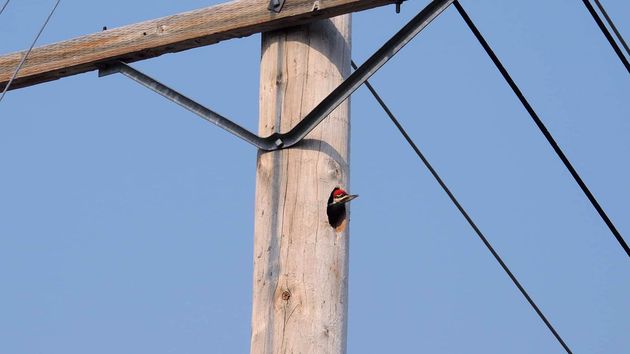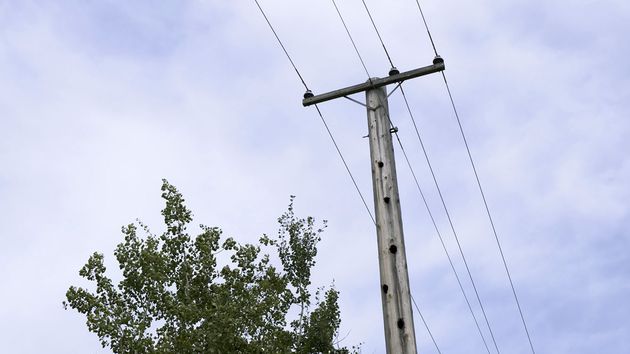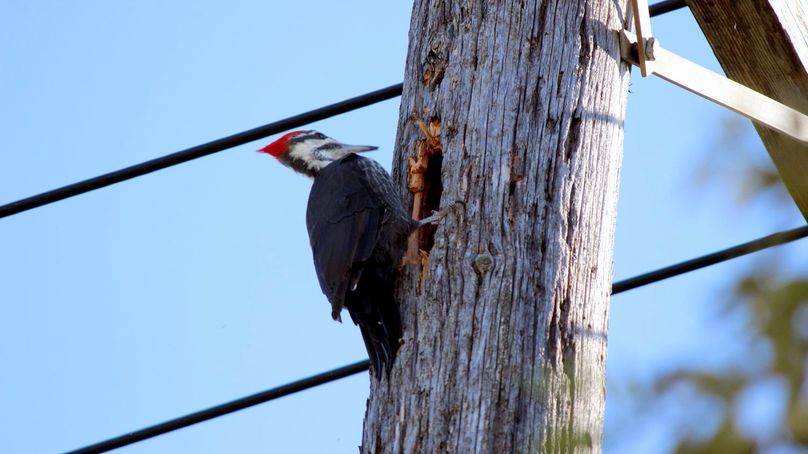Recent amendments to protected birds legislation – and in particular regarding pileated woodpeckers – means we had to change some of our processes surrounding our wooden poles.
According to the federal law, pileated woodpecker nesting cavities in wooden poles or trees are protected from removal or destruction, for a minimum of 36 months. With more than one million of our wooden poles across Manitoba, these changes mean we must adjust the ways we work on, repair and/or replace wooden poles.
We now are responsible for registering nest cavities on wooden poles in a new registry, the Government of Canada Abandoned Nest Registry.
“Part of my job is assessing poles that are due for repair or replacement,” said Patrick Carriere, Line Construction Contract Officer, Manitoba Hydro. “If I come across any poles with cavities in them, I examine the pole to see if they are indeed nesting cavities, as opposed to just a feeding or a roosting cavity.

Pileated Woodpecker in a nesting hole (Photo courtesy of Nancy King, Assiniboine Park Zoo)
“Once I deem a pole has a nesting cavity and needs to be protected, I flag it and then contact my environmental business partner to have it registered with the Abandoned Nest Registry.”
“Once the protected pole goes into the registry, a clock starts and the pole must remain in place for three years. Only after that period ends can the pole be removed, if the cavity remains unoccupied.”

Several woodpecker holes, indicating that it is not used for nesting
Collaboration with utility experts helped ensure legislative requirements were attainable
One of our internal teams developed guidelines and resources to help us abide by the new rules released in 2022. Under the guidance of our Transmission & Distribution Environment and Engagement department — and in collaboration with wood pole maintenance experts, federal regulators, neighbouring utilities, biologists and legal counsel — we worked to develop new practices for protecting nesting cavities while still maintaining our wood poles.
“It’s not only about understanding the law and making it work but managing how it affects operations for different groups across our organization,” said Jonathan Wiens, Environmental Specialist, Manitoba Hydro. “For example, clearly defining which types of cavities we need to protect — nesting cavities, rather than roosting or feeding holes — makes it easier for us and other industries to adapt to the change.
“We have been working with the federal government and other utilities on building a path that also works for us operationally, in terms of cost, reliability and safety while we protect our wildlife,” said Jonathan.
“And we’re doing well, too. When we compare our progress with other utilities, we’re actually ahead of the game.”
To help ensure everyone can understand the new requirements, Transmission & Distribution’s Environment & Engagement Department created training and educational materials, all targeted towards the different groups impacted by the amendments. These educational materials work hand-in-hand with new screening procedures as part of our digital pole maintenance program.
“We’ve been working with federal regulators and other Canadian utilities in developing the training materials,” Jonathan said. “Our environmental business partners, people like Michelle Ewacha, have been instrumental in disseminating that information down to various groups who need to be aware of all this.”
According to Michelle Ewacha, Station Operations and Construction Business Partner, Manitoba Hydro, “As part of managing the change, it’s important to get the message out by sharing it through different avenues. Whether that be one-on-one interactions with field crews or part of a departmental avian awareness presentation, I bring these changes up as part of the regular environmental update,” said Michelle.
Jonathan pointed out, “There may also be situations where we may urgently require a permit to replace a pole that has a nesting cavity – for example, when it’s a safety risk to our employees or is a reliability issue for our customers.
“We can request a permit or allowance from Environment and Climate Change Canada for removal or replacement of that pole. However, getting a permit every single time can be time-consuming, can add risk and can cause potential reliability issues for us.”
“There hasn’t been one such situation as of yet, but it is likely to arise in future and we want to be prepared for it.”
One idea is to monitor the results of pilot projects being led by other Canadian utilities. Some utilities are being granted a limited annual permit from Environment and Climate Change Canada to remove up to 25 inactive nest cavities per year.
“That could allow us to remove or replace a number of protected poles in a given year without seeking individual permits, which would reduce our time spent waiting in the event of safety or reliability issues,” Jonathan said. “We’re keeping an eye on what other utilities are doing and we are open to other ideas to help support this work.”

